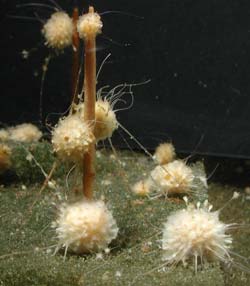Movement without Muscles

The sponge "Tethya wilhelma" has meanwhile become a model organism for evolutionary questions as well as an important subject of investigation within the current study of PD Dr. Michael Nickel from Jena University. Photo: Michael Nickel/FSU<br>
All animals move – cheetahs faster, snails more slowly. Muscle contractions are the basis of all movements, at least according to general opinion. But there are animal groups, that don't have any muscles at all, as they branched off from the evolutionary path before muscle cells evolved. However these animal groups, for instance the sea sponges, are not immovable. Sponges are able to contract without muscles. These contractions were already known to sponge divers in ancient Greece, as Aristotele described in 350 BC.
A group of scientists headed by associate professor Dr. Michael Nickel of Friedrich Schiller University Jena (Germany) is looking into movement without muscles. The scientists from the Institute of Systematic Zoology and Evolutionary Biology are mostly interested in the evolutionary aspect, especially in the question: Which evolutionary forerunners did the muscle cells derive from?
In a new study which will be published in the Journal of Experimental Biology (Band 214, doi: 10.1242/jeb.049148) on 15 May 2011, the evolutionary biologists are giving new answers to the question: Which cells in the sponges are contracting? In this paper the researchers are relying on the 3dimensional (3D) images, which they created with synchrotron radiation-based X-ray microtomography. Thus, the Jena scientists in co-operation with the Helmholtz-Zentrum Gesthacht at the Deutsches Elektronen Synchrotron Hamburg could compare and visualise the 3D structure of contracted and expanded sponges.
“A key feature of our approach is the use of 3D data for measuring the volume and surface of our sponges,“ says Nickel. “Although the 3D volumetric analysis is widely known and used in the technical sciences, it has rarely been used in zoology – in spite of its enormous information potential.“ Thus, Nickel's team was able to show that the inner and outer surfaces – and therefore the epithelial cells, so-called pinacozytes, cause the strong body contractions of the sponges. So finally, the Jena scientists could also settle a hundred year old debate about the cause of cellular contractions. Until now far spindle-shaped cells in the tissue of sponges as well as epithelial cells have been thought to be possible 'candidates' – but now the Jena scientists could identify the true initiator of the contractions.
The new findings of the researchers from Jena University make new approaches about the evolutionary development of musculature possible. “The early evolution of muscles has not been fully understood so far. According to current scientific knowledge muscle cells seem to have surfaced from nowhere“, Nickel says. “But surely there must have been evolutionary predecessor systems, that have been unknown until now.“ The sponge epithelial cells are now moving to the forefront in the evolutionary biologists' further research into the context of this. “There is a lot of evidence that the sponge epithelial cells and the muscle cells of all the other animals are going back to a common contractile cellular predecessor.“ In future this will be analysed by international co-operations, by also using genome and gene expression related data.
Original Publication:
Michael Nickel et al.: ”The contractile sponge epithelium sensu lato – body contraction of the demosponge Tethya wilhelma is mediated by the pinacoderm”, Journal of Experimental Biology, Vol. 214, doi: 10.1242/jeb.049148.
Contact:
PD Dr. Michael Nickel
Institute of Systematic Zoology and Evolutionary Biology with Phyletic Museum
Friedrich Schiller University Jena
Erbertstr. 1
D-07743 Jena
Phone.: ++49 (0)3641 949174
Email: m.nickel[at]uni-jena.de
Media Contact
All latest news from the category: Life Sciences and Chemistry
Articles and reports from the Life Sciences and chemistry area deal with applied and basic research into modern biology, chemistry and human medicine.
Valuable information can be found on a range of life sciences fields including bacteriology, biochemistry, bionics, bioinformatics, biophysics, biotechnology, genetics, geobotany, human biology, marine biology, microbiology, molecular biology, cellular biology, zoology, bioinorganic chemistry, microchemistry and environmental chemistry.
Newest articles

Silicon Carbide Innovation Alliance to drive industrial-scale semiconductor work
Known for its ability to withstand extreme environments and high voltages, silicon carbide (SiC) is a semiconducting material made up of silicon and carbon atoms arranged into crystals that is…

New SPECT/CT technique shows impressive biomarker identification
…offers increased access for prostate cancer patients. A novel SPECT/CT acquisition method can accurately detect radiopharmaceutical biodistribution in a convenient manner for prostate cancer patients, opening the door for more…

How 3D printers can give robots a soft touch
Soft skin coverings and touch sensors have emerged as a promising feature for robots that are both safer and more intuitive for human interaction, but they are expensive and difficult…





















